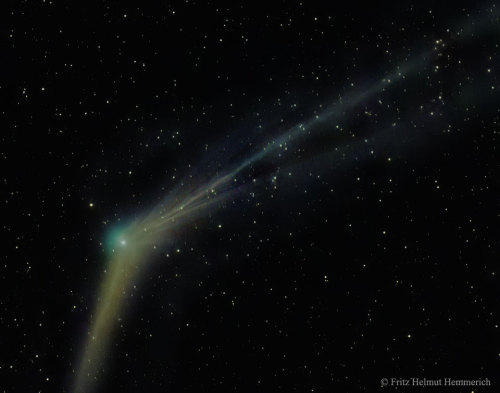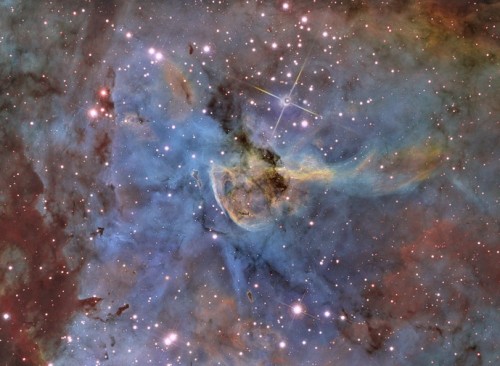Littlecadet-biguniverse - Space, Our Favorite Frontier!!

More Posts from Littlecadet-biguniverse and Others


Orion Nebula from HAWK-1 js

Herschel’s Eagle Nebula, some 6,500 light-years away.
Image Credit & Copyright: ESA/Herschel/PACS, SPIRE/Hi-GAL Project

Comet Catalina Emerges : Comet Catalina is ready for its close-up. The giant snowball from the outer Solar System, known formally as C/2013 US10 tails, making it an impressive object for binoculars and long-exposure cameras. The featured image was taken last week from the Canary Islands, off the northwest coast of Africa. Sky enthusiasts around the world will surely be tracking the comet over the next few months to see how it evolves. via NASA
js

Infrared Saturn Clouds via NASA http://ift.tt/2b5OdPE

Island Point Milky Way
Nikon d5100 - 6 x 25s - ISO 4000 - f2.8 - 16mm

Solar surges are cool jets of plasma ejected in the solar atmosphere from chromospheric into coronal heights. This particular surge has been captured in a loopy structure and streamed sunwards along the magnetic field lines.
Surges are associated with active regions and they are most likely triggered by magnetic reconnection and magnetohydrodynamic (MHD) wave activity. According to their morphological features, surge prominences can be classified into three types: jet-like, diffuse, and closed loop (above). Jet-like and diffuse surges are associated with coronal mass ejections (CMEs), but the closed-loop surges are not because the initial acceleration of the eruption is slowed down and finally stopped by the overlying coronal loops.
Credit: SDO/ LMSAL
'Enterprise' Nebulae Seen by Spitzer
NASA - Spitzer Space Telescope patch. Sept. 8, 2016
Image above: These nebulae seen by NASA’s Spitzer Space Telescope, at left, may resemble two versions of the starship Enterprise from “Star Trek,” overlaid at right. Image Credits: NASA/JPL-Caltech. Just in time for the 50th anniversary of the TV series “Star Trek,” which first aired September 8th,1966, a new infrared image from NASA’s Spitzer Space Telescope may remind fans of the historic show. Since ancient times, people have imagined familiar objects when gazing at the heavens. There are many examples of this phenomenon, known as pareidolia, including the constellations and the well-known nebulae named Ant, Stingray and Hourglass. On the right of the image, with a little scrutiny, you may see hints of the saucer and hull of the original USS Enterprise, captained by James T. Kirk, as if it were emerging from a dark nebula. To the left, its “Next Generation” successor, Jean-Luc Picard’s Enterprise-D, flies off in the opposite direction. Astronomically speaking, the region pictured in the image falls within the disk of our Milky Way galaxy and displays two regions of star formation hidden behind a haze of dust when viewed in visible light. Spitzer’s ability to peer deeper into dust clouds has revealed a myriad of stellar birthplaces like these, which are officially known only by their catalog numbers, IRAS 19340+2016 and IRAS19343+2026. Trekkies, however, may prefer using the more familiar designations NCC-1701 and NCC-1701-D. Fifty years after its inception, Star Trek still inspires fans and astronomers alike to boldly explore where no one has gone before.
Spitzer Space Telescope. Image Credits: NASA/JPL-Caltech
This image was assembled using data from Spitzer’s biggest surveys of the Milky Way, called GLIMPSE and MIPSGAL. Light with a wavelength of 3.5 microns is shown in blue, 8.0 microns in green, and 24 microns in red. The green colors highlight organic molecules in the dust clouds, illuminated by starlight. Red colors are related to thermal radiation emitted from the very hottest areas of dust. JPL manages the Spitzer Space Telescope mission for NASA’s Science Mission Directorate, Washington. Science operations are conducted at the Spitzer Science Center at Caltech in Pasadena, California. Spacecraft operations are based at Lockheed Martin Space Systems Company, Littleton, Colorado. Data are archived at the Infrared Science Archive housed at the Infrared Processing and Analysis Center at Caltech. Caltech manages JPL for NASA. For more information about Spitzer, visit: http://spitzer.caltech.edu http://www.nasa.gov/spitzer Images (mentioned), Text, Credits: NASA/Tony Greicius/JPL/Elizabeth Landau/Written by Robert Hurt, NASA’s Spitzer Science Center. Greetings, Orbiter.ch Full article

Eta Carinae and Keyhole Nebula (NGC 3324), inside the Carina Nebula (NGC 3372)
-
 dotglobal liked this · 11 months ago
dotglobal liked this · 11 months ago -
 venrooc reblogged this · 3 years ago
venrooc reblogged this · 3 years ago -
 thunderous3 liked this · 3 years ago
thunderous3 liked this · 3 years ago -
 dirhwangdaseul-archived reblogged this · 6 years ago
dirhwangdaseul-archived reblogged this · 6 years ago -
 thewizardofweird reblogged this · 6 years ago
thewizardofweird reblogged this · 6 years ago -
 jubilentj liked this · 6 years ago
jubilentj liked this · 6 years ago -
 fanxiacg liked this · 6 years ago
fanxiacg liked this · 6 years ago -
 bornhuntress liked this · 6 years ago
bornhuntress liked this · 6 years ago -
 aegeus-greekaegeansevresjuly1920 reblogged this · 6 years ago
aegeus-greekaegeansevresjuly1920 reblogged this · 6 years ago -
 aegeus-greekaegeansevresjuly1920 liked this · 6 years ago
aegeus-greekaegeansevresjuly1920 liked this · 6 years ago -
 thewizardofweird liked this · 6 years ago
thewizardofweird liked this · 6 years ago -
 lightcycler liked this · 6 years ago
lightcycler liked this · 6 years ago -
 abodeglued liked this · 6 years ago
abodeglued liked this · 6 years ago -
 kaleka0 liked this · 6 years ago
kaleka0 liked this · 6 years ago -
 melisa-may-taylor72 liked this · 6 years ago
melisa-may-taylor72 liked this · 6 years ago -
 metalzoic liked this · 6 years ago
metalzoic liked this · 6 years ago -
 nogthegingerninja liked this · 6 years ago
nogthegingerninja liked this · 6 years ago -
 thepizzalovingnerd liked this · 6 years ago
thepizzalovingnerd liked this · 6 years ago -
 chiefcatmeanie liked this · 6 years ago
chiefcatmeanie liked this · 6 years ago -
 carvingpotatoes liked this · 6 years ago
carvingpotatoes liked this · 6 years ago -
 thenighteternal liked this · 6 years ago
thenighteternal liked this · 6 years ago -
 therodentqueen liked this · 6 years ago
therodentqueen liked this · 6 years ago -
 katealot liked this · 6 years ago
katealot liked this · 6 years ago -
 um-pouco-de-tudo-blog-v liked this · 6 years ago
um-pouco-de-tudo-blog-v liked this · 6 years ago -
 nikko20o1 liked this · 6 years ago
nikko20o1 liked this · 6 years ago -
 isocelesnachos liked this · 6 years ago
isocelesnachos liked this · 6 years ago -
 ajc18615425 liked this · 6 years ago
ajc18615425 liked this · 6 years ago -
 jchrismoonlitshineworld liked this · 6 years ago
jchrismoonlitshineworld liked this · 6 years ago -
 delphicvoiceaddragh liked this · 6 years ago
delphicvoiceaddragh liked this · 6 years ago -
 homosapien-expansion reblogged this · 6 years ago
homosapien-expansion reblogged this · 6 years ago -
 afterthedragonflies liked this · 6 years ago
afterthedragonflies liked this · 6 years ago -
 cruz-world liked this · 6 years ago
cruz-world liked this · 6 years ago -
 iris-in-the-dark-world liked this · 6 years ago
iris-in-the-dark-world liked this · 6 years ago -
 stephdaninja liked this · 6 years ago
stephdaninja liked this · 6 years ago -
 fionamaccumhaill liked this · 6 years ago
fionamaccumhaill liked this · 6 years ago -
 genocider-syo-is-still-my-queen liked this · 6 years ago
genocider-syo-is-still-my-queen liked this · 6 years ago -
 a-freakishly-mutual-fad-rat liked this · 6 years ago
a-freakishly-mutual-fad-rat liked this · 6 years ago -
 w0rmholes liked this · 6 years ago
w0rmholes liked this · 6 years ago -
 simplygreenie liked this · 6 years ago
simplygreenie liked this · 6 years ago -
 toxiflorgalaxy reblogged this · 6 years ago
toxiflorgalaxy reblogged this · 6 years ago -
 wearethehallowe reblogged this · 6 years ago
wearethehallowe reblogged this · 6 years ago -
 wearethehallowe liked this · 6 years ago
wearethehallowe liked this · 6 years ago -
 andrewmc42 reblogged this · 6 years ago
andrewmc42 reblogged this · 6 years ago -
 andrewmc42 liked this · 6 years ago
andrewmc42 liked this · 6 years ago -
 cloverpayne liked this · 6 years ago
cloverpayne liked this · 6 years ago -
 lizethemotherlycat liked this · 6 years ago
lizethemotherlycat liked this · 6 years ago -
 z-meme-h liked this · 6 years ago
z-meme-h liked this · 6 years ago
GREETINGS FROM EARTH! Welcome to my space blog! Let's explore the stars together!!!
144 posts
